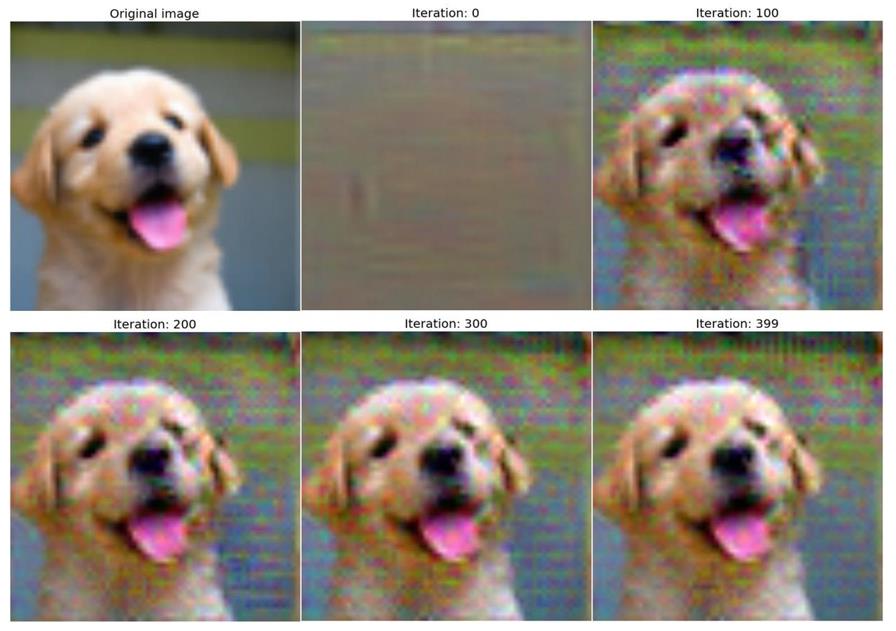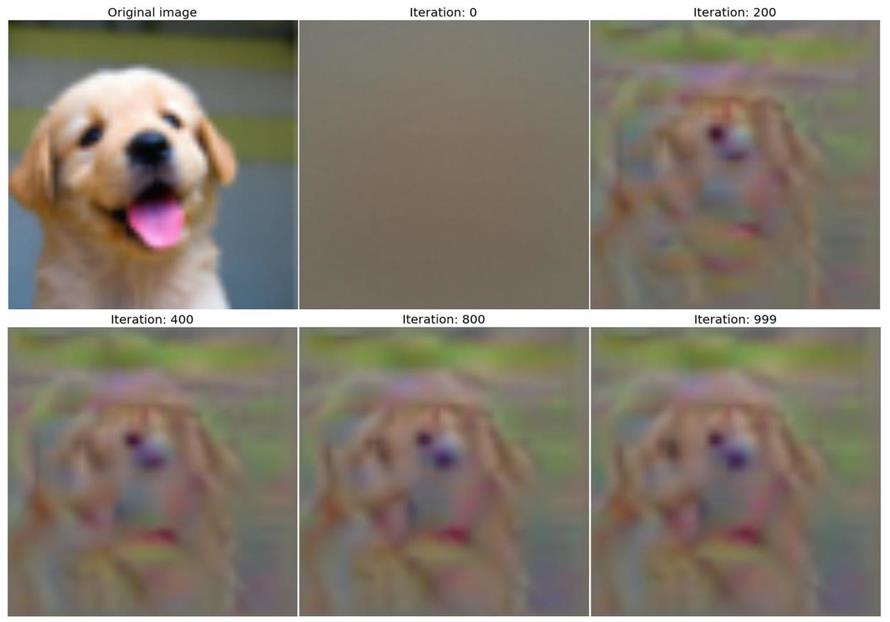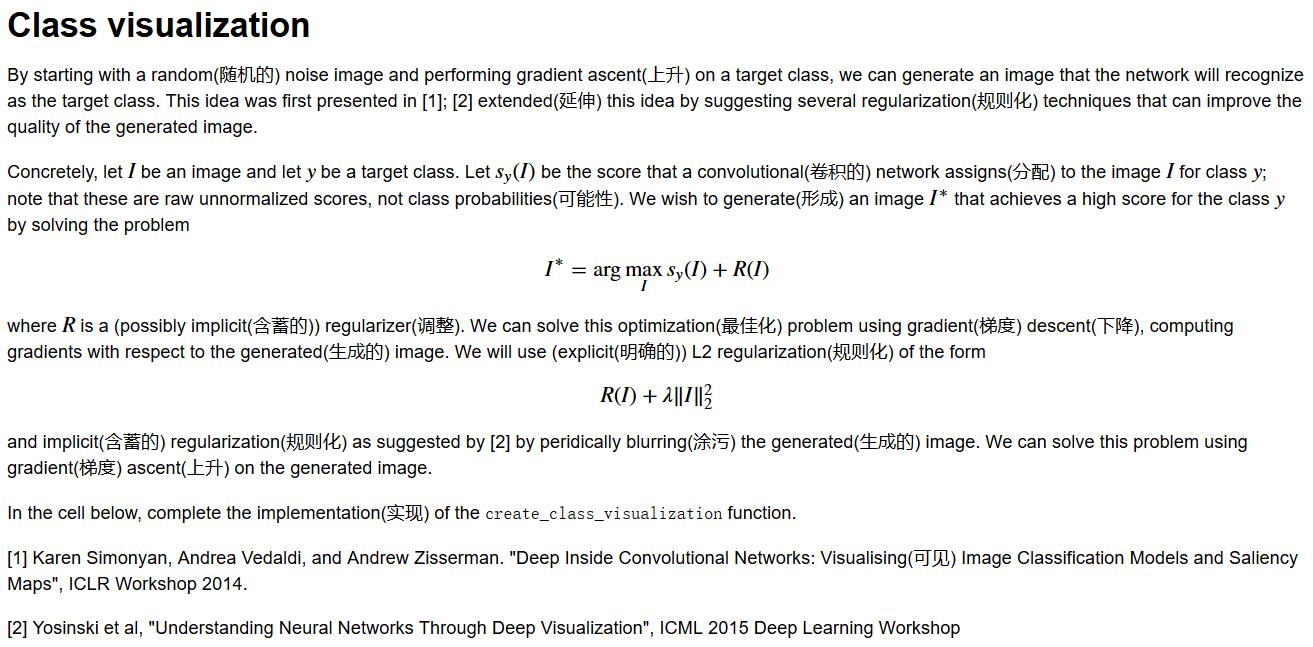『cs231n』作业3问题4选讲_图像梯度应用强化
Posted 叠加态的猫
tags:
篇首语:本文由小常识网(cha138.com)小编为大家整理,主要介绍了『cs231n』作业3问题4选讲_图像梯度应用强化相关的知识,希望对你有一定的参考价值。
【注】,本节(上节也是)的model是一个已经训练完成的CNN分类网络。
随机数图片向前传播后对目标类优化,反向优化图片本体
def create_class_visualization(target_y, model, **kwargs):
"""
Perform optimization over the image to generate class visualizations.
Inputs:
- target_y: Integer in the range [0, 100) giving the target class
- model: A PretrainedCNN that will be used for generation
Keyword arguments:
- learning_rate: Floating point number giving the learning rate
- blur_every: An integer; how often to blur the image as a regularizer
- l2_reg: Floating point number giving L2 regularization strength on the image;
this is lambda in the equation above.
- max_jitter: How much random jitter to add to the image as regularization
- num_iterations: How many iterations to run for
- show_every: How often to show the image
"""
learning_rate = kwargs.pop(\'learning_rate\', 10000)
blur_every = kwargs.pop(\'blur_every\', 1)
l2_reg = kwargs.pop(\'l2_reg\', 1e-6)
max_jitter = kwargs.pop(\'max_jitter\', 4)
num_iterations = kwargs.pop(\'num_iterations\', 100)
show_every = kwargs.pop(\'show_every\', 25)
X = np.random.randn(1, 3, 64, 64) # 64*64 image
for t in xrange(num_iterations): # 迭代次数
# As a regularizer, add random jitter to the image
ox, oy = np.random.randint(-max_jitter, max_jitter+1, 2) # 随机抖动生成
X = np.roll(np.roll(X, ox, -1), oy, -2) # 抖动,注意抖动不是随机噪声
dX = None
############################################################################
# TODO: Compute the image gradient dX of the image with respect to the #
# target_y class score. This should be similar to the fooling images. Also #
# add L2 regularization to dX and update the image X using the image #
# gradient and the learning rate. #
############################################################################
scores, cache = model.forward(X, mode=\'test\')
loss, dscores = softmax_loss(scores, target_y)
dX, grads = model.backward(dscores, cache)
dX = dX - 2*l2_reg*X # add L2 regularization to dX
X = X + learning_rate*dX # update the image X using the image gradient and the learning rate
############################################################################
# END OF YOUR CODE #
############################################################################
# Undo the jitter
X = np.roll(np.roll(X, -ox, -1), -oy, -2) # 还原抖动
# As a regularizer, clip the image
X = np.clip(X, -data[\'mean_image\'], 255.0 - data[\'mean_image\']) #
# As a regularizer, periodically blur the image
if t % blur_every == 0:
X = blur_image(X)
# Periodically show the image
if t % show_every == 0:
plt.imshow(deprocess_image(X, data[\'mean_image\']))
plt.gcf().set_size_inches(3, 3)
plt.axis(\'off\')
plt.show()
return X
1.L2正则化参数是可训练的参数,所以这里就是图片的全部像素
2.更新X的时候,需要对目标I(图片)求导,所以有L2正则化偏导数项
3.抖动和之前常接触的噪声是不同的,是指图像行列(单行单列非图像整体)随机平移随机个单位,且在最后需要还原
蜘蛛类图像重建:


随机数图片向前到指定层,对标准图片的特征图计算距离,反向传播优化原图片
def invert_features(target_feats, layer, model, **kwargs):
"""
Perform feature inversion in the style of Mahendran and Vedaldi 2015, using
L2 regularization and periodic blurring.
Inputs:
- target_feats: Image features of the target image, of shape (1, C, H, W);
we will try to generate an image that matches these features
- layer: The index of the layer from which the features were extracted
- model: A PretrainedCNN that was used to extract features
Keyword arguments:
- learning_rate: The learning rate to use for gradient descent
- num_iterations: The number of iterations to use for gradient descent
- l2_reg: The strength of L2 regularization to use; this is lambda in the
equation above.
- blur_every: How often to blur the image as implicit regularization; set
to 0 to disable blurring.
- show_every: How often to show the generated image; set to 0 to disable
showing intermediate reuslts.
Returns:
- X: Generated image of shape (1, 3, 64, 64) that matches the target features.
"""
learning_rate = kwargs.pop(\'learning_rate\', 10000)
num_iterations = kwargs.pop(\'num_iterations\', 500)
l2_reg = kwargs.pop(\'l2_reg\', 1e-7)
blur_every = kwargs.pop(\'blur_every\', 1)
show_every = kwargs.pop(\'show_every\', 50)
X = np.random.randn(1, 3, 64, 64)
for t in xrange(num_iterations):
############################################################################
# TODO: Compute the image gradient dX of the reconstruction loss with #
# respect to the image. You should include L2 regularization penalizing #
# large pixel values in the generated image using the l2_reg parameter; #
# then update the generated image using the learning_rate from above. #
############################################################################
feats, cache = model.forward(X, end=layer, mode=\'test\') # Compute the image gradient dX
loss = np.sum((feats - target_feats)**2) + l2_reg*np.sum(X**2) # L2 regularization
dfeats = 2*(feats - target_feats)
dX, _ = model.backforward(dfeats, cache)
dX += 2 * l2_reg * X
X -= learning_rate * dX
############################################################################
# END OF YOUR CODE #
############################################################################
# As a regularizer, clip the image
X = np.clip(X, -data[\'mean_image\'], 255.0 - data[\'mean_image\'])
# As a regularizer, periodically blur the image
if (blur_every > 0) and t % blur_every == 0:
X = blur_image(X)
if (show_every > 0) and (t % show_every == 0 or t + 1 == num_iterations):
plt.imshow(deprocess_image(X, data[\'mean_image\']))
plt.gcf().set_size_inches(3, 3)
plt.axis(\'off\')
plt.title(\'t = %d\' % t)
plt.show()
小狗图片浅层特征重建:

小狗图片深层特征重建,可以看出来特征更为抽象:


目标图片向前传播到指定层,把feature map作为本层梯度反向传播回来,优化原图片
def deepdream(X, layer, model, **kwargs):
"""
Generate a DeepDream image.
Inputs:
- X: Starting image, of shape (1, 3, H, W)
- layer: Index of layer at which to dream
- model: A PretrainedCNN object
Keyword arguments:
- learning_rate: How much to update the image at each iteration
- max_jitter: Maximum number of pixels for jitter regularization
- num_iterations: How many iterations to run for
- show_every: How often to show the generated image
"""
X = X.copy()
learning_rate = kwargs.pop(\'learning_rate\', 5.0)
max_jitter = kwargs.pop(\'max_jitter\', 16)
num_iterations = kwargs.pop(\'num_iterations\', 100)
show_every = kwargs.pop(\'show_every\', 25)
for t in xrange(num_iterations):
# As a regularizer, add random jitter to the image
ox, oy = np.random.randint(-max_jitter, max_jitter+1, 2) # 随机抖动值生成
X = np.roll(np.roll(X, ox, -1), oy, -2) # 随机抖动
dX = None
############################################################################
# TODO: Compute the image gradient dX using the DeepDream method. You\'ll #
# need to use the forward and backward methods of the model object to #
# extract activations and set gradients for the chosen layer. After #
# computing the image gradient dX, you should use the learning rate to #
# update the image X. #
############################################################################
feats, cache = model.forward(X, end=layer, mode=\'test\') # Compute the image gradient dX
dX, grads = model.backward(feats, cache)
X += learning_rate*dX
############################################################################
# END OF YOUR CODE #
############################################################################
# Undo the jitter
X = np.roll(np.roll(X, -ox, -1), -oy, -2)
# As a regularizer, clip the image
mean_pixel = data[\'mean_image\'].mean(axis=(1, 2), keepdims=True)
X = np.clip(X, -mean_pixel, 255.0 - mean_pixel)
# Periodically show the image
if t == 0 or (t + 1) % show_every == 0:
img = deprocess_image(X, data[\'mean_image\'], mean=\'pixel\')
plt.imshow(img)
plt.title(\'t = %d\' % (t + 1))
plt.gcf().set_size_inches(8, 8)
plt.axis(\'off\')
plt.show()
return X
迭代次数少的图片没什么效果,迭代次数多的图片贼鸡儿恶心(密控退散图,效果不开玩笑的... ...),不放示例图了,想看的自己搜DeepDream吧,网上图片一堆一堆。Ps,我一直很怀疑这个deepdream这东西除了看起来比较‘玄幻’外到底有什么实际意义... ...
以上是关于『cs231n』作业3问题4选讲_图像梯度应用强化的主要内容,如果未能解决你的问题,请参考以下文章
『cs231n』作业1问题1选讲_通过代码理解K近邻算法&交叉验证选择超参数参数
CS231n笔记3--Gradient Descent与Backward Propagation
